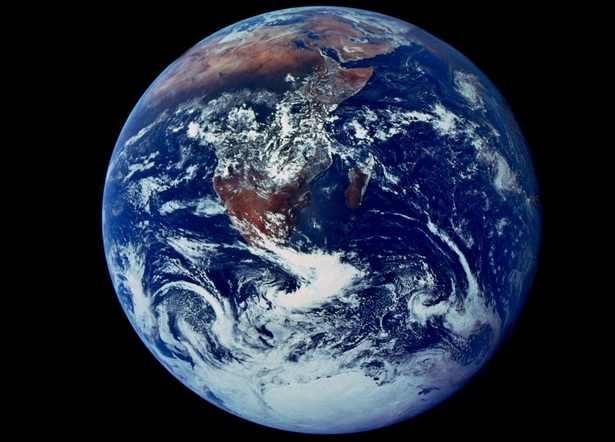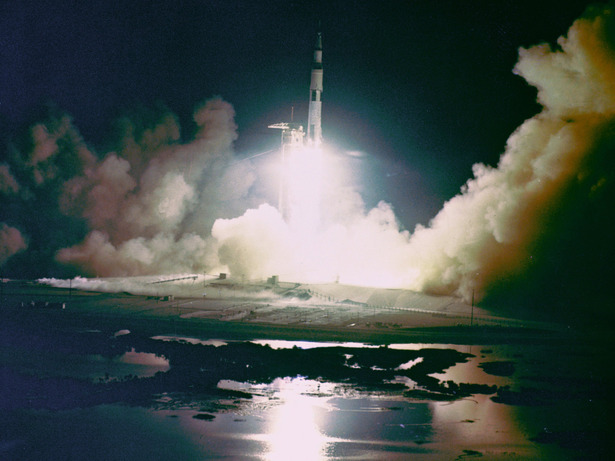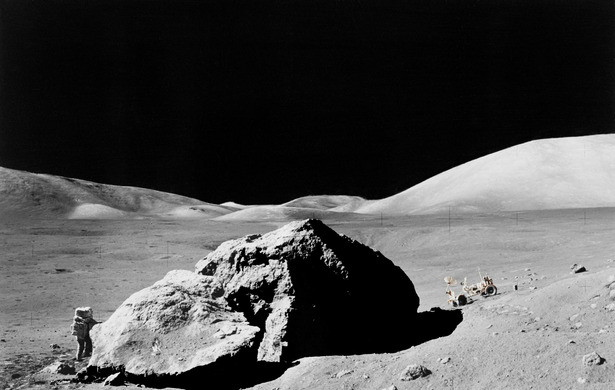The incredible story behind an image we've all seen hundreds of times, possibly the most reproduced photograph in history
It's an iconic image we have all seen hundreds of times, possibly thousands, and probably the most widely reproduced photograph in history. Because it's in the public domain it has been used for everything from car commercials to the Earth Day flag, printed on T-shirts, postage stamps, billboards, book covers, mouse pads -- most any surface you can print on. It even has its own Facebook page. In the NASA archive its formal designation is AS17-148-22727 but it's commonly known as The Blue Marble Shot, and forty years later we still aren't sure who actually took it.
It was the first photograph taken of the whole round Earth and the only one ever snapped by a human being. You can't see the Earth as a globe unless you get at least twenty thousand miles away from it, and only 24 humans ever went that far into outer space. They were the three-man crews of the nine Apollo missions that traveled to the moon between 1968 and 1972, six of which landed there successfully (three men went twice). But only the last three saw a full Earth.
In order to see our planet as a fully illuminated globe you need to pass through a point between it and the sun, which is a narrower window than you might think if you're traveling at 20,000 miles an hour. Most of the men who flew lunar missions saw neither a full Earth nor a full moon; both heavenly bodies were partly in shadow -- complementary shadows, like lovers walking past a streetlamp -- the entire flight. Their trajectories were determined by the landing sites they were scouting or targeting, and those were mainly on the eastern face of the moon as seen from Earth.
If you were at the controls of a spacecraft attempting to land on the moon you wanted the sun behind you at an angle between seven and twelve degrees above the horizon, so it cast long shadows from boulders you might not see otherwise. This means that you were aimed at a crescent moon when you launched from Earth three days before. The first landing on Apollo 11, for instance, blasted off toward a new quarter-moon and the crew saw no more than a three-quarter Earth.
It wasn't until the last Apollo mission that NASA targeted a landing site on the far western face of the moon: the rumpled Valley of Taurus Littrow, which earthly geologists thought might be the least disturbed and thus primordial of the possible landing sites. This meant launching toward a nearly full moon, which in turn meant departing from Florida at night. It was the only night launch of the mighty Saturn V, the most stupendous rocket ever built, and took place on December 7, 1972.
The Saturn V Rocket launch of December 7, 1972. NASA.
The three men atop the rocket were Eugene Cernan, the Commander of Apollo 17; Harrison "Jack" Schmitt, the Lunar Module Pilot who would accompany Cernan down to the surface if all went well; and Ron Evans, the Command Module Pilot who would remain in lunar orbit, keeping their return ship running while his crewmates did the glamorous exploring. All three have claimed that they took the famous Blue Marble Shot.
On the five previous Apollo missions the commanders, all space veterans, were allowed to choose who would land with them on an alien world. All had picked rookies, loyal sidekicks they felt comfortable with and confident in. For Apollo 17 Cernan had chosen Joe Engle, a former X-15 pilot, and the two trained for months as the backups for Apollo 14. Then by established NASA policy they rotated together to prime crew status on Apollo 17.
But then Congress canceled the funding for Apollo 18, which also had a crew that trained together for months. The Lunar Module Pilot on that crew was Jack Schmitt, a Harvard-trained geologist who was a scientist-astronaut. Six of them were selected amid great nerdy fanfare in 1965 but none had been assigned to a mission until Schmitt got a seat on the very last planned flight. They were generally regarded as dorks by the pilot astronauts, Right Stuff bravos like Cernan and Engle who between them had flown a hundred different aircraft, from helicopters to rocket planes, landing on everything from heaving carriers to empty deserts. When political pressure bumped Engle in favor of Schmitt on Apollo 17 a very odd couple was sent to the moon.
They were busy as hell the first six hours. Lunar missions only made two orbits around the earth, three hours of frantic preparation before cranking it up to escape velocity. They were coming around to the daylight side for the third time when the last booster fired for six minutes to propel them away from the human planet. There were a thousand critical things they had to do next: separate from that final booster stage, accomplish a delicate docking maneuver with the service module, reorient and stabilize their new combined spacecraft, check all the various systems and compute their trajectory, and climb out of the awkward hardsuits they'd been wearing since blast-off.
They weren't supposed to be taking pictures. Photo sessions were scheduled events in a rigorous flight plan that detailed every step essential to success. The film itself was strictly rationed like everything else on those perilous flights; there were 23 magazines onboard for the 70mm Hasselblad cameras, twelve color and eleven black-and-white, all intended for serious documentation purposes. They weren't supposed to be looking out the window, either.
But they couldn't help it, none of them. If you talk to any of the lunar travelers today -- eighteen of them are still alive -- they will talk most about and remember best the stolen moments of watching their home world shrink behind them. It was a blue-green beacon in a vast black cosmos, beguiling them on a cellular level, getting smaller by the minute. Forty years later the journey that lives most intensely for them was more about leaving the Earth than going to the moon.
At five hours and a few minutes into the flight of Apollo 17 one of the crewmen looked out the window. What he saw inspired him to grab the only Hasselblad that wasn't stowed and snap a picture -- actually four pictures, no more than a minute apart, changing the exposure after the first one. The second snap yielded the sharper image that's become famous, so a minute's attention was involved. But whoever did it said nothing on the radio or to their crewmates about it. It's possible they did it instinctively, hardly thinking about it, because none of them thought to mention it for weeks.
It wasn't until the flight returned safely ten days later, and the film was processed at the photo lab in Building 8 of the Johnson Space Center, that a film technician named Dick Underwood realized what he was looking at: the first photograph of the whole, fully illuminated, astonishingly beautiful Earth. It created an immediate sensation, printed on the front page of nearly every newspaper on the planet, the image of our world as we had never seen it before.
The Earth was nearing winter solstice at the time so the South Pole was tilted sunward, cupping the planet in a clean white bowl. White clouds swirl north over deep blue oceans and the green middle of the African continent, then a tan arc caps the image with the dry lands of Arabia. All around this perfect colorful circle is blackness so dense it defines infinity. It's an unmistakable portrait of a living world and it is arresting.
(The true camera image is upside-down by earthly standards, showing the South Pole at the top of the globe, because the camera was held by a weightless man who didn't know down from up. Most reproductions invert it to align with our expectations.)
Most people who glanced out the window and saw something like that would be distracted no matter how busy they were. That's what happened on Apollo 17 when the spacecraft was some 28,000 miles from Earth and crossing the path between it and the sun. All three men aboard had mission-critical tasks to perform at the time, tasks they had simulated hundreds of times on the ground. Tasks they could almost do automatically. And they weren't immune to astonishment.
After the picture became famous all three remembered seeing that remarkable sight and each was pretty sure they had snapped the shot. NASA policy is to credit the entire crew for all mission photography, so there is no official position. Ron Evans died in 1990 without relinquishing his claim, and forty years later there is still a running argument between Cernan and Schmitt about who took the Blue Marble Shot. Those four decades have shown it to be the most significant thing they brought back from their expedition, far more meaningful than the moon rocks they gathered, so it matters to them. A lot.
Eugene Cernan (left) and Harrison "Jack" Schmitt. NASA.
On the 30th anniversary of their flight in 2002, the filmmaker James Cameron sponsored a reunion celebration in Los Angeles. Among the events was a lavish dinner at a Hollywood mansion. A limousine was dispatched to fetch Cernan and Schmitt from their hotel. Schmitt grabbed it first and told the driver to get moving, stranding Cernan and his wife. After the dinner Cernan returned the insult by stranding Schmitt and his wife. They won't even ride in the same stretch limo together.
Unbiased space enthusiasts who obsess over issues like this have generally given credit for the shot to Schmitt because he had less to do at that point in the mission. As the commander Cernan should have been focused on the crucial operations called for in the flight plan. He had a spacecraft to pilot. Also Schmitt was a scientist, a trained observer more inclined, presumably, to document his observations. Hence he's been given the benefit of the doubt.
I'm not convinced. Going back to the 1980s I have interviewed both men several times, separately and together, originally for a documentary film but since then because I remain fascinated by their extraterrestrial adventure. I spent more time with Cernan, however, because he's a much better interview. He was a network commentator for years during Space Shuttle flights, a proven glib talker, while Schmitt became a U.S. Senator who was too pedantic to get re-elected. He's a good man but a deadly public speaker.
During the first half-day of the flight Schmitt spent more time at the windows than the other two combined, but he never said a word about seeing a whole Earth. Instead he gave long-winded weather reports, once going on for half-an-hour about storms developing in the southern hemisphere. It's entirely possible he was studying the trees and missed the forest.
On the other hand, here is Cernan on the subject of window gazing: "You have to literally just pinch yourself and ask yourself the question, silently: Do you know where you are at this point in time and space, and in reality and in existence, when you can look out the window and you're looking at the most beautiful star in the heavens -- the most beautiful because it's the one we understand and we know, it's home, it's people, family, love, life -- and besides that it is beautiful. You can see from pole to pole and across oceans and continents and you can watch it turn and there's no strings holding it up, and it's moving in a blackness that is almost beyond conception."
Both men are certain they snapped The Blue Marble Shot and can't believe the other won't admit it. They can get rather snarky about it and that's a shame. They each deserve to be remembered better for their uncontested moments. Schmitt discovered volcanic rocks that proved to be the oldest samples returned from the moon, while Cernan was the last man to walk there, an exit he dignified with humility and grace we can all be proud of. It doesn't particularly matter who took the picture as long as we have it.
A photo Cernan took of Schmitt near a rock formation on the moon. NASA.
We want to hear what you think about this article. Submit a letter to the editor or write to letters@theatlantic.com.




